

 |
November 21, 2014: Touring Historic Lima |
 |
Return to the Index for Our Stay in Lima |
Today, we are going to spend most of our time in two Lima museums. First, we'll visit the Castillo Mineral Museum located back at Plaza San Martin. Then we'll head over to the Larco Museum of Peruvian Culture to have lunch and tour through this major museum. We'll finish the day with an evening walk in the park south of our apartment.
Plaza San Martin
|
|
 |
As we did yesterday, we left the central station and walked north on Carabaya Street to Plaza San Martin. As we were walking up Carabaya, we came to an intersection where there was another street performer reminiscent of the dancing couple we'd seen in Quito a week ago. This time, the performer was a single person in costume with a dummy attached to him/her so that it appeared there were two people dancing. But the method was the same; when the light on Carabaya turned red, the performer would come out into the crosswalk, do his dance routine and then solicit donations from the stopped cars. Maybe these kinds of performances are some South American custom- who knows?
Also along Carabaya, we passed the Edificio Encarnacion, which is apparently just an office building along the street, but one with an interesting name. It didn't appear to be religious in nature, as one might have assumed, and I've been unable to find out much about it.
As you saw yesterday, the walk from the Central Station to Plaza San Martin was about four or five blocks, and we were there pretty quickly after getting off the bus. Just before we got to the Plaza, Fred noticed and photographed a whimsical balcony above us.
|
The location of the plaza previously was home to the San Juan de Dios hospital which was torn down in 1850 and replaced by a railway station, which in turn was torn down between 1911 and 1918. The Plaza as we see it today was inaugurated on July 27, 1921 in celebration of the 100th anniversary of the independence of Peru.
The design, ornamentation, furnishing, and gardening of Plaza San Martin was designed by Manuel Piqueras Cotolí. The benches and handrails were constructed out of marble and the paving, of granite. There were also four water fountains, bronze streetlamps, and flower-filled gardens.
Here are clickable thumbnails for some of the pictures I took this morning of this beautiful plaza:
 |
The construction of the buildings that surrounded the plaza occurred at a gradual pace. The Colón Theater and the Giacoletti buildings were the first structures to be built and were erected in 1914 before the construction of the plaza. The other buildings were later built in stages. The Hotel Bolivar was built in 1924 and the other buildings surrounding the plaza were constructed up through 1940. You can see some of these buildings here, and you can see Avenue Nicolas de Pierola leading northwest from the Plaza here. The plaza maintains uniformity with respect to its buildings' facades, with the overall appearance primarily baroque in a neocolonial style.
The Castillo Mineral Museum
|
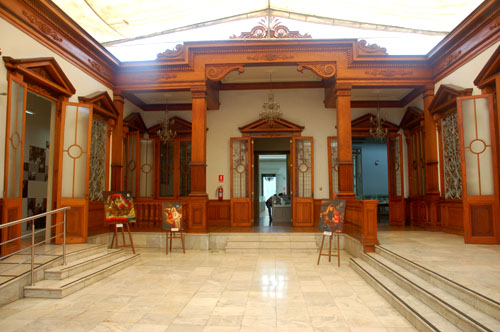 |
This museum is a family memorial to one of its members who died in a skydiving accident in 2006 involving a unit of Peru's National Guard. Perhaps we might just read the dedication we found in the atrium of the Museum:
|
"Casa Belen, house of Science, History and Culture is named Andrés Del Castillo Rey (1985-2006), in memory of our dear son who was a brilliant student of Mining Engineering. It is my wish and also of her mother Veronica that his name is remember in order that he serves as an example for future generations. We have built this beautiful Museum as a contribution to the development and knowledge of Peru. In the Mining Room, we display the most important crystallized mineral collection of the country. The Chancay Ceramics were present until a few years ago only in gardens, now they appear in a preferential place, where its great variety stands out. We have an exhibit for the first time of the way of life and clothing of old Peruvians. The fundamental objective of the Casa Belen is to become a living Museum, open to all the people of Perú, it can be used for artistic presentations that include popular music; presentation of classes in the study and conservation of ceramic and textiles; in summary we aim to maintain the spirit of promotion of the arts in all its forms." Guido Del Castillo |
Before we head into the Museum proper, I want to include here three more pictures of the lovely entrance hall:
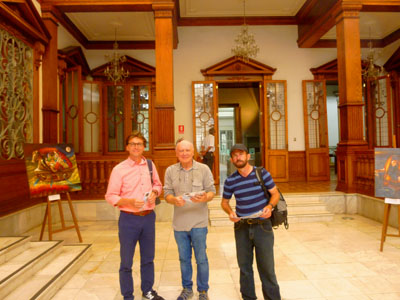 |
 |
 |
In the pictures above, you might notice some colorful artwork on easels behind us. These turned out to be fanciful paintings done by a Peruvian artist (I did not record who) but they were really interesting. You can see a close-up of one of them here.
The museum is basically a large main hall with smaller display rooms to each side. The main hall had an intricate, multi-leveled coffered ceiling with rows of windows that let in a great deal of natural light. In the main hall are display cases for many of the museum's specimens. Most everything in the main hall was done in shades of white and grey, better, I suppose, to showcase the bright colors of many of the specimens. The exception was the beautifully-tiled floor, whose border and main pattern set off the displays very nicely. You can see a different view of the coffered ceiling here, and of the main displays here.
|
There were a couple of signs around stating that photography of the specimens in the main hall was not allowed, and I guess I can understand that if the museum were crowded, flash photography would be distracting. But I wanted to come away with at least a few pictures from the main hall, and so I turned my flash off and snapped some pictures of a few of the specimens. There are clickable thumbnails below for some of these pictures:

|
The main hall was pretty much in the center of the building; left of it was a hallway leading to offices and various function rooms. To the right of the main hall was another display room for smaller specimens. These were arranged in display cases along the long wall, with artwork above. You can see one of these display cases with its multitude of small specimens here.
Back in one corner, there was a closed room where the fluorescent minerals were on display, and here we could take pictures. With the normal lights on, the room was pretty nondescript- just a small room with a few display cases. But when the normal lights were switched to black fluorescent lights, the specimens came alive. Click on some of the thumbnails below and you'll see what I mean:
 |
Peruvian minerals was the main focus of the exhibits here at the Castillo Museum, but there were some additional rooms towards the back of the building that contained exhibits of Peruvian sculpture and pottery.
|
Eventually, the other guys found their way back to where I was, and I snapped a picture of the three of them. You can see that picture here. The Castillo Museum of Minerals was very interesting, and the building was architecturally interesting as well. When we were done, we went back out to Plaza San Martin, since it appeared that the weather had cleared.
The Grand Bolivar Hotel
 |
I also made two movies as we were walking to the Grand Bolivar, one just after we left the Castillo and one as we were walking alongside the plaza. You can use the players below to watch these movies:
|
|
|
The Gran Hotel Bolívar, is a historic hotel located on Plaza San Martín in Lima, Peru. Designed by noted Peruvian architect Rafael Marquina, it was built in 1924 and was the first large, modern hotel built in Lima. I found I was quite close to the actual building so I had to walk across to the Plaza to get a good picture.
|
In 1938, the architect was recommissioned to add two more floors and 150 more rooms; his redesign kept the hotel looking seamless. Oilman John Mecom bought the hotel in 1961 for $2 million. The Hotel Bolivar was declared National Monument by Supreme Resolution 2900, of December 28, 1972. We followed Greg and Yoost into the hotel, and as we were walking through it to find the bar/restaurant, Fred and I took some pictures in the skylit atrium:
 |
A great deal of forethought went into the design of all the buildings surrounding Plaza San Martin. This structure, like the others, utilizes the unifying style of Spanish Baroque, giving a Neocolonial aspect to the entire Plaza. In the 1940s and 1950s, the hotel attracted Hollywood movie stars such as Orson Welles, Ava Gardner, and John Wayne, where many also discovered the local cocktail, the Pisco Sour, served in the hotel's main bar- where we were heading.
|
|
We had something to drink and some small snacks while we chatted and plotted out route to the Museo de Larco. Fred and I took a few pictures here at our table, and there are clickable thumbnails below for some of them:
 |
When we were done eating, we left the hotel by a side entrance out onto Avenue Pierola where we got our last look at Plaza San Martin before hailing a taxicab for the ride to the Museo de Larco. As we were riding through Lima in the cab, Fred was snapping the occasional street scene. Here are clickable thumbnails for some of his pictures:
 |
Of course, Greg, who was in the front seat, was chatting up the taxi driver in a combination of Spanish and English, while the three of us sat in back watching the scenery go by. I, myself, was a bit amused that, apparently, here in South America there are no restrictions on using the GPS screen to access television and other content while you are driving! Our taxi driver kept glancing down at some kind of Peruvian talent show.
|
|
|
At one point, the taxi drove by what from a distance looked like a construction site but which was actually an archaeological excavation.
|
A few years ago, a similar site was unearthed somewhat northwest of Huaca Pucilana, and it was this new site we passed in our taxi. Fred got a couple more pictures when we asked the drive to slow in front of the site, and you can click on the thumbnails below to see them:
 |
The ride to the Larco Museum, situated in a residential area about a mile inland from the coast and some two or three miles northwest of our apartment, took about 25 minutes.
The Larco Museum of Pre-Columbian Art
|
I want to break our visit here into four sections of pictures. First, we'll take a look at the outside of the museum; the plantings around the building and the sunken lawn, especially the bougainvillea, were very, very colorful. Next, we can take a look at the restaurant which is on the lower level on the north side of the sunken lawn, and at the pictures we took during lunch. After that, we took a tour through the separate collection of erotic art that is housed in the building next to the restaurant, again on the lower level on the north side of the lawn. Finally, we will tour through the Larco Museum itself.
To begin our visit, you can click on the two thumbnail images below. The first picture is the entry to the museum complex from Larco Park next door, and the second is the entry courtyard and the sign directing us to the ticket desk:
 |
Now that we have our tickets, we can begin to explore the Larco Museum. We are going to have lunch in the restaurant that is here, but before we do that, I want to take you around the outside of the museum building to have a look at the beautiful plants and flowers.
The Outside of the Larco Museum: Plants and Flowers
|
 |
Actually, we spent quite a bit of time outside the Larco Museum- wandering the grounds, having lunch, and so on. All around the grounds the foliage and flowers were pretty spectacular.
|
To view the slideshow, just click on the image at right and I will open the slideshow in a new window. In the slideshow, you can use the little arrows in the lower corners of each image to move from one to the next, and the index numbers in the upper left of each image will tell you where you are in the series. When you are finished looking at the pictures, just close the popup window.
From the ticket office/gift shop, we headed up the ramp. Actually, I was following the other folks up as I had stopped to take some of the flower pictures you've seen already.
|
|
After I completed that movie, I went back to the corner of the museum building and took a picture looking back down the ramp to the ticket office and gift shop that you can see at the bottom.
At the top of the sloped ramp, we turned to the right to come onto the patio outside the front of the museum. Walking a few feet, you could turn and look back at the top of the ramp. Directly ahead of us, again looking north, there was another ramp that descended to the level of the restaurant and lawn below, and I took a picture of that flower-lined ramp. In a while, we will be eating lunch at the bottom of that ramp in the restaurant off to the right, and I'll take a picture looking up the ramp then. Walking a bit further onto the patio, Fred got another view looking back towards the top of the initial ramp and the turn we made, and you can see that view here.
|
We planned on going down to the restaurant for our lunch, but before we went down the stairs at the east side of the patio, I thought I would take a couple of panoramic pictures from this vantage point. The first one I tried took eight pictures, and shows the entire patio area from the top of the ramp up all the way around to the east corner and the front of the Larco Museum- almost 360°. That view is in the scrollable window below:
For the other panorama, I wanted to take in the lawn below the esplanade, the restaurant and the building containing the exhibition of erotic art. This was just a combination of three pictures, and you can see the result below:
 |
Lunch at the Larco Museum Restaurant
|
 |
We went down a set of stairs and ramp to the lower level and over to the restaurant side of the lawn. From there, we got good views of the lawn and museum; click on the thumbnails below to have a look:
 |
When we got to the lower level, we were at the east end of a trellis-covered walkway that ran along the outside of the building housing the erotic art collection. We'd be sticking our heads in there after lunch. Along the walkway there were benches to rest on and lots of ferns hanging down on both sides of the trellis. At the west end of the walkway, we turned to our right and entered the restaurant proper. The walkway continued, but now there were restaurant tables along it and some dining parties already at lunch. You can see that portion of the restaurant here.
|

|
Before we head into the collection of erotic art, there is one more photograph I want to include here. You may remember that I took a photograph during the Celebrity-provided lunch in Quito of an interesting way that the restaurant had of identifying men's and women's bathrooms. Well, when I went to use the facilities, I found two unmarked doors- one on the left and one on the right- at the end of a short hall. The only identifying information were two clay figures mounted on the wall between the two doors. These turned out be very much in keeping with the theme of the museum of erotic art next door to the restaurant. If you'd like to see the figures, and aren't easily offended, then just click here.
The Exibition of Pre-Columbian Erotic Art
We took many pictures in the three galleries of the exhibition, and I am going to include the best of them here, along with explanations where available. Before you proceed further, however, you should be aware that Pre-Columbian art incorporates detailed representations of male and female genital organs, as well as scenes in which men and women participate in sexual acts. If you think that you might not want to look at the images in this section of my photo album, then you should skip over them and go directly to our tour of the main Museo del Larco. To do so, simply click the link immediately below:
However, if you would like to continue with this section and accompany us through the galleries of erotic art, then click the link below:
Just in case you chose the wrong selection earlier, here is one more chance for you to skip over the pictures of Pre-Columbian erotic art. To skip directly to the tour of the Larco Museum of Pre-Columbian (non-erotic) Art, please click the link below:
However, if you would like to continue with this section and accompany us through the galleries of erotic art, then click the link below:
Just one more step. Federal regulations require that visitors to web sites that display "adult" content verify that they are 18 years old or older. Please select one of the options below:
| I Certify I am 18 Years Old or Older | Darn it! I'm Not 18 Years Old Yet. |
|
This gallery displays a selection of the archaeological objects Larco collected. Rafael Larco, honest with his readers and aware of the complex nature of the field he was tackling as he sought to arrive at a coherent interpretation of this unique artistic tradition, concluded his work by saying:
| "As we come to the end of this book on one aspect of the archaeological panorama of Peru for which our only source is erotic vessels, readers are free to explore for themselves the vast field of suggestion." (Checán, p.128) |
This gallery provides us with a clearer understanding of the world view of the societies of ancient Peru. At the same time, it offers a unique and fascinating opportunity for the study of sexuality, free of our own myths and prejudices.
NOTE:
We took a huge number of pictures here in the gallery of erotic art. You may not want to see a lot of them, so in this section I will show you just a few that are representative and then put the rest of the pictures in a slideshow at the end of this section.
|
 |
There have been various interpretations of "erotic pottery", but the one that is most widely accepted today is its relationship to a larger system of representations that includes, among others, themes that can be observed in detail in the other galleries of the Larco Museum.
|
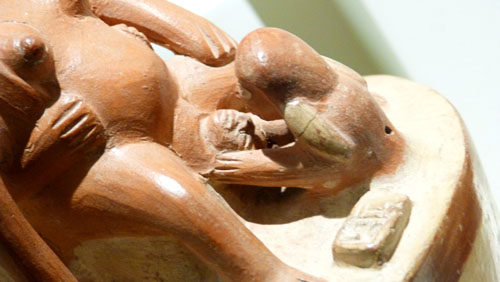 |
As you can see so far, the pottery and ceramics were pretty explicit, and from our point of view in a more prudish time, many would focus solely on the images and fail to consider them in light of the cultural milieu during which they were created. What we might consider a subject only to be dealt with behind closed doors, the Pre-Columbians saw as in integral and essential part of their belief system and culture.
|
| "The task I set myself to discuss in this book has been only one aspect of the life and culture of the Machicas and other peoples of pre-Columbian Peru - that related to their sexual life as shown in the pottery found in their tombs - the only source of any information on it... As the erotic pottery was not modeled to stimulate the senses, it is a study I have carried out as an archaeologist." |
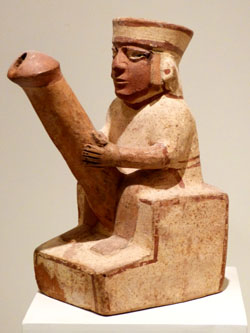 |
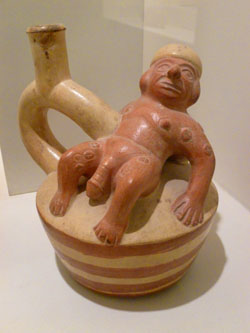 |
In pre-Columbian art there are, for example, detailed representations of male and female genital organs which allude to the concept of duality. There are also representations which symbolize fertility and the origin of life, in which men and women participate in sexual acts with beings from other worlds, such as deities or the dead.
There exist representations which obviously narrate episodes from myths, as well as sexual acts with clear ritual connotations. In order to understand these, it is important to consider the larger context of pre-Columbian artistic representations in general. In this way we are able to see that sexual representations are related to other themes, such as funerary practices and sacrifice ceremonies.
|
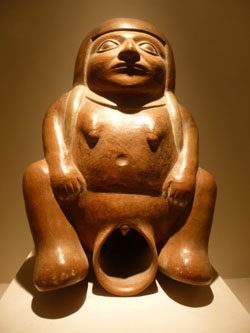 |
 |
In Andean Art, and perhaps in art in all cultures and at all times, there was a direct relationship between the subjects depicted in the artwork and the view that the culture had of their natural surroundings- their "cosmovision". Even today, and even with subjects not related to larger themes, we always marvel when an artist seems to get the "feeling" of his subject.
|
The World of the Gods
The god Ai Apaec copulates, giving origin to life. He inseminates the woman, the earth, and from this union the first fruits are produced. This union is performed at specific moments during the agricultural calendar, such as when the time for irrigating or planting begins.
|
In the earthly world, humans join to procreate. The union between man and woman makes new life possible. In this world, the animals also copulate and in this way they insert themselves into the cycle of life.
In somewhat of a departure from other cultures, however, the third element of the Andean cosmovision, the dead, consists of beings that are far from molding in the ground.
The World of the Dead
The dead are depicted as sexually active beings that interact among themselves and also with the living. The sexual activities in which the dead are involved are non-procreative. The objective of these acts is the emission of semen, the fertilizing liquid, which must be offered to the earth. Living men and women also perform sexual acts that do not lead to procreation; these types of sexual interaction symbolically link the world of the living with the world of the dead.
We saw just about all there was to see in the erotic art collection. While we'd seen pictures of some of these items before, the sheer number of them was overwhelming- particularly considering that each of these items had to have been unearthed from an archaeological dig or from a tomb. It makes one wonder how many other objects there must be- of all types.
|
To view the slideshow, just click on the image at right and I will open the slideshow in a new window. In the slideshow, you can use the little arrows in the lower corners of each image to move from one to the next, and the index numbers in the upper left of each image will tell you where you are in the series. When you are finished looking at the pictures, just close the popup window.
The Larco Museum of Pre-Columbian Art
From the Erotic Art Collection (If you bypassed the tour of that collection and have had second thoughts about doing so, it is not too late to have a look at the many pictures we took in the three galleries. To take the tour, just click here.), we came back up the stairs to the entrance to the Rafael Larco Herrera Museum of Pre-Columbian Art.
As it turned out, we spent a great deal of time in this most interesting museum and we took lots of pictures. To supplement those pictures, I recorded descriptions and the narrative from various plaques throughout the museum. All this information has led to a web page section that is quite large. In the interests of keeping my photo album pages of reasonable size (so that they load fairly quickly and are not too hard to navigate), I want to put the photos and narrative for the Larco Museum of Pre-Columbian Art on their own page. To get there, all you have to do is click on the link below. At the end of your tour through that museum, there will be a link to bring you back to this page so you can spend the last part of our last day in Lima with us.
Well, we all thought that the Larco Museum of Pre-Columbian Art was incredibly interesting, and if you walked through it with us, I am sure you will agree.
Now it is time for us to head back to the apartment, where Yoost will be leaving for the airport and his flight back to Amsterdam while we will do some walking around this evening before we, too, head to the airport.
Our Last Evening in Lima
|
I have no idea what route we took back to the apartment; traffic was horrendous and the taxi driver was always weaving in and out or taking side streets to try to avoid some of it. Almost all of the pictures we took out the taxi window didn't turn out well, although I did get one picture of an interesting monument as we drove back.
Once we were back at the apartment, we futzed around for a while while Yoost got his stuff together. Our host's driver arrived about five, and we bid goodbye to Yoost as we saw him off to the airport.
We ourselves got our stuff in some semblance of order, hung out for a while, and then Fred and I went out for an evening walk.
|
|
|
As it turned out, the evening was very pleasant, although a bit overcast. But this had its own benefits, as we were treated to a very nice sunset over the Pacific.
|
 |
The way Lima is situated atop the 80-foot cliffs is interesting; most oceanfront cities, like Miami or Los Angeles, sit low near water level, so there are no drop-offs at the beach. Lima is more like San Francisco, though, where when you drive over to the beach you might park relatively high up and have to hike down to water level. Of course, developers in Lima put highrises right by the ocean.
Here are clickable thumbnails for some of the picturees that we took as we were walking along through the parks towards the lighthouse and back:

|
The walk was really pleasant, and the evening a nice one. I found myself wishing we could have gone further up or down the shore, but time was not unlimited.
|
The last thing we did on our walk was to go down towards the beach. To do that, we had to go back up Balta a block or so to find the first set of stairs down into Parque Carossio. This brought us to the road that we could take to go down towards the shore, underneath the lighted bridge above us.
|
 |
Back at the apartment, we did our packing and just relaxed until about 11:30 when our host's driver showed up to take us out to the airport for our 2:30AM flight back to Dallas. As it turned out, the flight was delayed almost two hours, but since we had the First Class Lounge to hang out in, the time passed fairly quickly, and by 5AM on my 68th birthday we were in the air and heading home to Dallas- after an amazing trip to a part of the world we'd not come close to before.
You can use the links below to continue to another album page.
 |
November 21, 2014: Touring Historic Lima |
 |
Return to the Index for Our Stay in Lima |